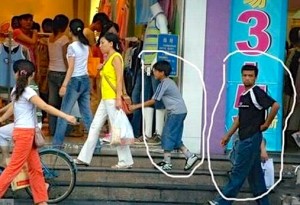“Taking such radical steps is certainly no easy decision…[but] the few must be sacrificed for the many, as they say…The bank will be safeguarded and consolidated, society will go on as before, investments will continue, jobs will be retained and shareholders will suffer no losses. And who, in the meantime…do you think might bother to check up on how the pygmies of Dja are progressing?”—Jens Brage-Schmidt, Chairman of the Karrebaek Bank.
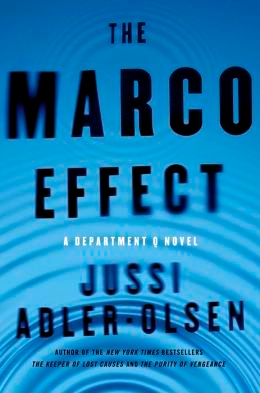 Jussi Adler-Olsen’s fifth novel in the Department Q series, under the “leadership” of Copenhagen Detective Carl Morck, continues the story of Morck and his unconventional assistants who operate out of a basement office dedicated to the solution of cold cases. A victim of PTSD from a case in which he was wounded by a nail gun, with one of his men left paralyzed from the neck down and another one killed, Morck has been consigned to the basement, out of the way of the rest of the Copenhagen Police Department, which keeps him on only because they need the money which Parliament has granted for the cold cases that Morck’s department investigates. An alcoholic loner, Morck has hired as his assistants two other loners with problems and mysteries associated with them. A man from the Middle East named Hafez-el-Assad, a name he shares with the former President of Syria, has an almost instinctive ability to discover connections between cases and to obtain information. Rose, who started as a secretary and who is famous for her piercings, has gradually progressed into case work. None of the three in Department Q fear the wrath of the higher-ups or care what anyone else thinks.
Jussi Adler-Olsen’s fifth novel in the Department Q series, under the “leadership” of Copenhagen Detective Carl Morck, continues the story of Morck and his unconventional assistants who operate out of a basement office dedicated to the solution of cold cases. A victim of PTSD from a case in which he was wounded by a nail gun, with one of his men left paralyzed from the neck down and another one killed, Morck has been consigned to the basement, out of the way of the rest of the Copenhagen Police Department, which keeps him on only because they need the money which Parliament has granted for the cold cases that Morck’s department investigates. An alcoholic loner, Morck has hired as his assistants two other loners with problems and mysteries associated with them. A man from the Middle East named Hafez-el-Assad, a name he shares with the former President of Syria, has an almost instinctive ability to discover connections between cases and to obtain information. Rose, who started as a secretary and who is famous for her piercings, has gradually progressed into case work. None of the three in Department Q fear the wrath of the higher-ups or care what anyone else thinks.
The Marco Effect begins obliquely. A man from a Baka village of pygmies in Cameroon, Louis Fon, is working with a Danish bank which funds development work in this rural, remote area. After receiving a cellphone call in the jungle, he realizes that his discovery of funding irregularities puts his life at risk, and he has only enough time to type out a message (which is unreadable) before he is attacked. Further development of this plot line shows the massive corruption of the funding bank in Denmark, and the administrators in Cameroon who are responsible for using the funds for the betterment of the rural Baka area. The bank, in danger of closing, has found a way to “recycle” the funding from Denmark to Cameroon and then back to the Danish headquarters and to the officers of the company. The novel moves back and forth in time, with information parceled out carefully to maintain as much suspense as possible. Other deaths soon occur.
A second plot line takes place in Copenhagen, where a group of gypsies, mostly children, under the leadership of a sadistic and violent “spiritual” leader, roam the streets, picking pockets, begging, and doing petty crimes in order to meet their monetary quota each day. Marco, one of the young men still in his early teens, publicly challenges the leader, his own uncle, and, as a result, finds himself running for his life. Marco has dreams of college, of becoming a doctor, and of being successful, though he is not allowed to attend school, and his frantic efforts to avoid being caught by his uncle and a loose confederation of gypsy groups throughout Europe keep the suspense high.
A third subplot concerns a cold case in which a woman is killed in the explosion of the houseboat on which she lives, and questions arise as to whether this is an insurance scam, a murder by her husband, or some other kind of crime. As always seems to be the case with police departments as they are depicted in crime novels, interdepartmental rivalries and jealousies threaten Morck and his assistants. As each of these plot threads unspools, the question of how, if at all, these threads will connect becomes a paramount interest for the reader.
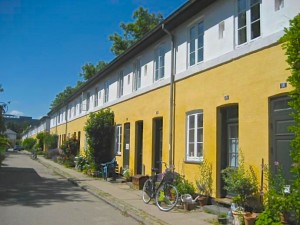
Brumleby, a 19th century development in which two hundred forty units, all alike, were built to house medical personnel. Carl assigns Rose the job of interviewing a huge number of residents here in an effort to find a suspect in the houseboat crime.
Adler-Olsen has always excelled at keeping interest high both through his dramatic action and through his use of wonderful repeating characters as they continue to develop. New sides of Morck appear here, including his laziness regarding his romantic involvements, and Assad is shown to have some skills at interrogation which make Morck and the reader wonder where he learned them. Rose, over time, has become a mystery. Her personality seems to shift and change with each novel, from giggly office girl in The Keeper of Lost Causes, to a woman with major psychiatric problems in A Conspiracy of Faith, to a woman known more for her piercings than for her obvious talent as an investigator in this novel. Peripheral characters are often intriguing, and Marco draws in the reader with his desire to become a person with a future, showing much ingenuity in avoiding a constant series of death traps.
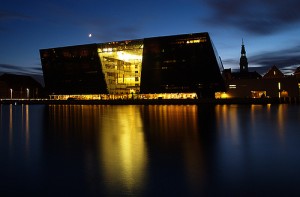
The Black Diamond wing of the Royal Danish Library becomes a factor in this novel when Marco discovers that some of the gypsy children are using it for their own purposes.
Though nearly all crime thrillers rely on coincidence to some extent, the coincidences in this novel especially strain credulity. In the first twenty pages, the first of these appears, as a man from Sweden, who has no other role in the novel, spontaneously offers to use his talents to help decode the last message of Louis Fons in Cameroon for a man from the Copenhagen bank. Later Marco, with a part-time job putting up and then taking down posters, miraculously comes across the photo of a man to whom he is unexpectedly connected, a photo posted several years ago. And an even greater coincidence occurs when Rose, at a local café, sees exactly the same photo and finds that it provides her with information as important to her as it has been to Marco. The most unlikely coincidence of all occurs when a magazine is found inside a house which has been closed for a couple of years, and, surprise, it is a magazine to which someone has subscribed and therefore has the person’s name and, more importantly, address on it. An unusual coincidence involving a secret connection between Assad and another person working in the police department raises even more questions about the legitimacy of using coincidence to resolve plot issues.
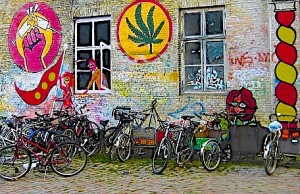
Freetown Christiania, a "free state" within Copenhagen, is the site of a climactic scene. Photo by Kieran Lynam.
The novel, at five hundred pages, is packed with action, but the overall structure is weak, as are the connections among the plot lines. One subplot, involving the explosion on the houseboat is completed within the first three hundred pages and disappears. The connection between the gypsy subplot and the Danish bank defies credulity, no matter how desperate the head of the bank might be. Ultimately, the novel feels artificial and contrived, in need of editing and the kind of careful attention to detail which was so obvious in Adler-Olsen’s first novel of the series, The Keeper of Lost Causes.
ALSO by Adler-Olsen: THE KEEPER OF LOST CAUSES, THE ABSENT ONE, A CONSPIRACY OF FAITH, THE PURITY OF VENGEANCE
Photos, in order: The author’s photo appears on http://acornerofthelibrary.blogspot.com
A Baka hut in Cameroon, part of a pygmy community, was photographed by Corinne Staley for http://fortheinterim.com/the-pygmies-of-east-cameroon/
Child pickpockets, like those with whom Marco was associated, are shown on http://caminosantiago2.blogspot.com
Brumleby, a 240-unit residential complex built in the mid-19th century for medical workers, is an area in which Morck and Rose look for a person the need to talk to. Morck eventually gives the job of visiting all these buildings, which look alike to Rose, who is undaunted by the task. http://www.kulturarv.dk/
The Black Diamond building of the Royal Danish Library is shown on this site: http://jakeincopenhagen.wordpress.com/
ARC: Dutton
Freetown Christiania, an area which celebrates personal freedom, is the site of a climactic scene in the novel. Photo by Kieran Lynam. http://www.quirkyguide.com/place/christiania-denmark
![jussi-adler-olsen[1]](http://marywhipplereviews.com/wp-content/uploads/jussi-adler-olsen1.jpg)

